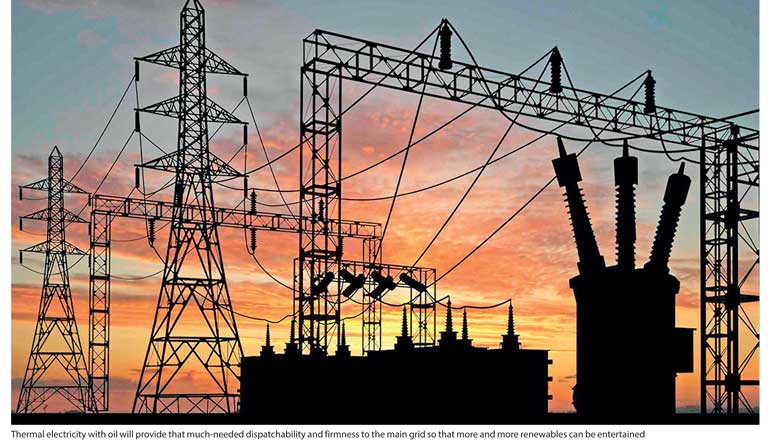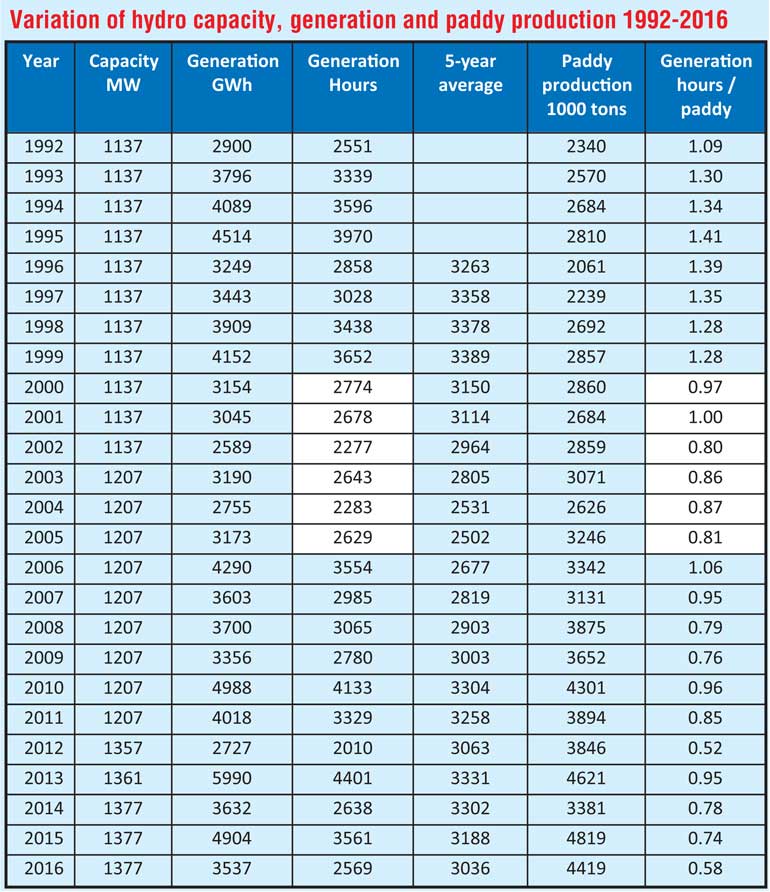Thursday Dec 18, 2025
Thursday Dec 18, 2025
Wednesday, 8 November 2017 00:00 - - {{hitsCtrl.values.hits}}

 We read Dr. Tilak Siyambalapitiya’s article titled ‘Power Crisis Misunderstood’, which appeared in the Daily FT of 10 October 2017 with great interest. We were not surprised by its contents, which basically suggested that Sri Lanka should build more coal power plants.
We read Dr. Tilak Siyambalapitiya’s article titled ‘Power Crisis Misunderstood’, which appeared in the Daily FT of 10 October 2017 with great interest. We were not surprised by its contents, which basically suggested that Sri Lanka should build more coal power plants.
We have already written a few articles on this argument and mentioned that once we take the overall cost of coal power to the economy, which will include not only the nominal cost of coal per se i.e. Rs. 7.28 as per his table, but also the cost of hydropower lost and cost of agricultural production lost – the cost of a unit will be anything from Rs. 80 per kWhr, the figure for 2014 - to Rs. 110 per kWhr in 2016.
The contentious issue here will be whether these two losses can be attributed to the coal power plant. This needs to be explained on two frontiers – one that coal power plants reduce hydropower in general and second whether the argument is valid for Sri Lanka. I intend to address both in this article.
When the Public Utilities Commission had its public consultations on 15 June 2017, I delivered a presentation through which I showed the Hadley and Walkers atmospheric circulations relevant for Sri Lanka and emphasised that we need to safeguard our hydro energy, the chief architect of which is venerated both at the CEB as well as at the IESL, from being chopped on the drawing board as well as in the field.
We showed how with a total capacity of 1377 MW the maximum hydro capacity was estimated to be 5,000 GWhrs only in the 2018 plan which was under consideration while in the 2006 plan the maximum capacity was estimated to be 5,900 GWhrs, with a total capacity of only 1,200 MW. I believe the PUCSL would have taken note of that.
We agree with Dr. Siyambalapitiya that hydropower generation does not remain constant from year to year. In fact even at the PUCSL consultations we mentioned this. But we went further than Dr. Siyambalapitiya and (i) calculated the running hours of hydro by dividing generation by capacity (as the capacity has increased from 1,137 MW in 1992 to 1,377 MW in 2016), (ii) compensated for year-to-year variations by using a five-year moving average and (iii) tried to identify whether rainfall/weather has really been the issue by dividing the annual number of hours of electricity generation by the paddy production and arrived at the table shown. Ten copies of this table were given to the PUCSL Director General at the end of the session.
One of the key things this table shows is that prior to 2005 – the year in which that bold decision to opt for a coal power plant was made – hydrogeneration was low for five consecutive years while paddy production did not indicate any such drop. This may be due to (a) the reservoirs not being filled up due to fears of their walls being compromised, (b) agricultural production in the Mahaweli areas being given priority over electricity generation in decisions made about the usage of water available in the reservoirs, (c) the need to prepare the mindset of the public for hydro generation being that low even without coal power, etc. We can explain most of the variations in this table.
The other noticeable thing in these figures from 1992-2016 is that out of the five years which yielded the lowest number of production hours, three, including the lowest, have been after 2011 when coal power came into being. Of course we have excluded the period from 2000-2005.
At the consultation session I requested PUCSL not to allow a repetition of that 2000-2005 scenario. While it happened during the ascending half of a solar cycle, we are currently (that includes 2016 as well) in the descending half of a solar cycle and there should be more precipitation during the coming five years of course if not for the coal power plant.
We are aware of the cyclical behavior of hydropower which may result from the 11-year solar cycle and we do not want to be blind to such variations. But if we foresee hydro being reduced due to such solar cycles what we should do is see what will be available during such times.
When our hydro is struck by a drought, the obvious option available will be solar. We do not intend to discuss the limitations – availability, dispatchability and firmness – here but we are aware of these and please note that there is no source of energy which is free of these or other more dangerous limitations. In respect of any source of energy we will have to strike a balance. And in 2030, the peak demand of 4,726 MW will occur during the day time.
Now we need to discuss as to why we say that coal power generation leads to the loss of hydropower. For  hydropower to operate, surface water evaporation and precipitation should take place in a timely fashion as per the path taken by the Earth around the Sun. If these two phenomena are disturbed by any aspect, that aspect is capable of influencing hydro energy generation capacity. When you generate 900 MW of coal energy at 80% capacity, you are generating 6.9 Mt of CO2 per annum.
hydropower to operate, surface water evaporation and precipitation should take place in a timely fashion as per the path taken by the Earth around the Sun. If these two phenomena are disturbed by any aspect, that aspect is capable of influencing hydro energy generation capacity. When you generate 900 MW of coal energy at 80% capacity, you are generating 6.9 Mt of CO2 per annum.
This CO2 does not get distributed across the entire 5.1 x 108 km2 global landscape because this will be restricted by large-scale atmospheric circulations Hadley in the North-South direction and Walkers in the East-West direction.
I showed these circulation models at the PUCSL consultation session. According to the Hadley circulation, our atmospheric air with this additional CO2 (about 15 Mt due to other sources and this 6.9 Mt due to coal per annum) will move North up to 300N at 120 – 150 Sverdrups (Sv), drop the moisture and comeback with CO2 only.
Of course, on its way back in the South Indian region, if there is favourable precipitation, it will lose some CO2 to support growth of vegetation and as a result, rainfall might take place around February to May in Sri Lanka.
There are research findings published to show how rainfall, growth of vegetation and CO2 intake happen together in this part of India. If you look at the longitudinal circulation at 80E, the flow rate will be about 0-10 Sv. This is why we say that the CO2 concentration increase above Sri Lanka does not get distributed across the globe as we would like to believe.
In fact, I have been measuring the CO2 concentration in my garden in Thalawathugoda using a handheld meter and from 3 March 2017 to 20 October 2017 it has increased from 495 ppm to 550 ppm. This indicates a significant increase in CO2 concentration worthy to be taken note of. There are results of research carried out on how this increase at lower levels gets distributed over the entire thickness of the troposphere in global climate change journals.
With this CO2 coming from the coal power plant, the rate of increase of CO2 in our atmosphere is 330 t of CO2 per km2 compared to a global average of 75t of CO2 per km2.
Elementary Climate Change theory says that when the CO2 concentration in the atmosphere increases, the atmospheric temperature increases and such temperature increases bring more water vapour to the atmosphere at the rate of a 7% per degree Centigrade rise in temperature and this could bring more temperature increase. This implies that coal power plants will reduce precipitation and as a result both hydropower capacity as well as agricultural production will suffer.
The real blame of any misunderstanding in this respect should be put on the global climate scientist community which has brought in this concept of country-wise per capita CO2 generation as if there are computers in the atmosphere connected to maternity hospitals and cemeteries.
If one wants to calculate the impact of getting a specific amount of tourists from a certain country on our climate, then these per capita generation values may be useful. This is another point I clarified at the PUCSL consultation session.
Usually, they say that water in the atmosphere does about 40 cycles per year and if conditions for a drought persist even for two months we will lose about six spells of rainfall. If we keep on emitting 6.9Mt of CO2 per year from coal power plant, it could lead to the atmosphere accommodating 382 mcm of water vapour more than before. This water vapour may go to 300N and land there and the Sri Lankan landscape in that part of the country could run dry and the Mahaweli reservoirs will not have enough water to yield the targeted hydropower quantities. This may explain why there is less rainfall to fill our hydro energy reservoirs. This is what I referred to as saving hydro energy from getting chopped in the field.
Furthermore, when we use coal, unlike in the case of oil or gas generation, there is no new water vapour entering the atmosphere and the water which is required to maintain constant relative humidity has got to come from the ground. So are you surprised that our agricultural production goes down by as much as 50% and we have to import rice and is it unreasonable that we also add that to the cost of coal power generation? Where does this ground water from places in the northern part of Sri Lanka ultimately land? It is in places like Delhi, etc. which experienced torrential rains recently. This is what I meant when I said at the PUCSL session that CO2 without H2O is the worst situation for Sri Lanka.
In September 2015, at the previous public consultation session of the PUCSL, I very clearly mentioned that Sri Lanka needed to invest in non-fossil fuel energy generation when fossil fuel prices are low.
There may be a lot of pressure on the authorities from the IMF or oil-producing countries to reduce local prices whenever global prices come down; but we believe that it is not the most prudent thing to do. When the prices come down, we should invest our savings in local energy generation projects so that when global prices go up eventually we can be self-sufficient to a large extent.
If, on the other hand, we lower prices, demand goes up and along with that global prices will also go up and we will remain in this eternal external debt trap. If we want to remain continuously indebted to the IMF, World Bank, oil rich countries, etc. then of course we should link our oil prices to global oil prices.
In an earlier article on energy security, I compared these two mindsets to those of the ant and the grasshopper. The choice is simple: break free of our current mindset and vulgar slavery to current day power blocks. We should always provide for the future generations as they will have to live in a much more challenging future.
If ever we want to retire any energy projects dependent on oil then that should be thermal transportation and not thermal electricity. This is for the following few reasons:
(a) Thermal transportation is the energy sector which wastes the most amount of foreign exchange for a unit of energy actually used because during thermal transportation we are wasting 80% of the energy content we have purchased paying valuable foreign exchange.
(b) The energy we waste due to thermal transportation is more than the total electrical energy we consume in any year. This is true for the world (62.4 EJ vs 61.7EJ in 2004), the US (1395QnBThu vs. 1280QnBThu in 2009) and Sri Lanka (80 PJ vs. 38 PJin 2012).
(c) The ill effects of thermal transportation by way of the emission of greenhouse gases (CO2, etc. and water vapour leading to significant increases in rainfall where it is not welcome) per unit of energy actually consumed is the highest
(d) Even at the Climate Summit of September 2015 it was spelt out that thermal transportation should be retired by setting a target of 30% of new vehicles to be free of thermal energising by 2030 (e) Well-known manufacturers of vehicles have already set very specific targets for retiring the manufacture of thermally energised vehicles. This is another aspect we mentioned at the PUCSL session with comparison data.
Thermal electricity with oil will provide that much-needed dispatchability and firmness to the main grid so that more and more renewables can be entertained, especially in a setup moving towards having the daily peak of 4,726 MW during the day time in 2030.
I believe that this article will contribute towards understanding the power crisis more holistically and taking us to a more energy secure future.
(The writer is the Managing Director of Somaratna Consultants Ltd.)